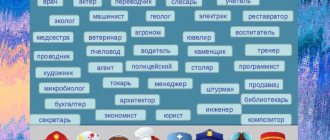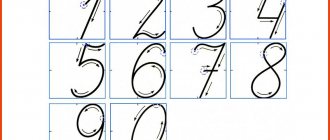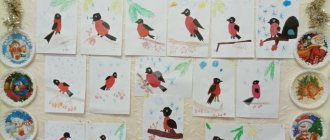Abstract of the open GCD in the preparatory group for the OO "Cognition". Composition of number 7
Abstract of educational activities for children 6-7 years old on the educational program “Cognition” (mathematical and sensory development) “Composition of the number 7”
Goal: to consolidate knowledge about the composition of the number 7. Objectives: 1. Educational: • To consolidate the ability to decompose the number 7 into two smaller numbers; • Consolidate knowledge about the days of the week, the colors of the rainbow; • Strengthen the ability to use a ruler to draw segments; • Strengthen the ability to perform graphic dictation under dictation; • Learn to color pictures using numerical color notations; 2. Developmental: • Develop spatial and logical thinking; • Develop attention, memory, speech, imagination; • Develop the ability to evaluate your work independently; • Expand children's horizons. 3. Educational: • Cultivate a sense of compassion, a desire to do good; • Develop the ability to listen to other children without interrupting. Didactic material: 1. Ballpoint pens, colored pencils, rulers, glue stick for each student; 2. Checkered sheets (2 pieces) for each student; 3. An envelope with painted buckets and a set of colored paper fish for each student; 4. A4 sheet of paper with an image of an octopus for each pupil; 5. A4 sheet with an image of ladybugs for each pupil; 6. Color by number sheet for each student; 7. Self-assessment sheet “Seven Flowers” and a set of seven petals for each student; 8. Illustration from the fairy tale “Snow White and the Seven Dwarfs”; 9. Illustration “Rainbow”; 10. Illustration “Nuts”; 11. Image of a ladybug. Progress of educational activities: Teacher: Hello, guys! Look, guests came to our lesson today. They want to see what you can do and what you know. Therefore, we need to try and not be distracted. Introduction to the game situation: That day has come! We are not too lazy to study. Let's hold hands tightly and smile at each other. We will look at the guests, It will immediately be more fun! Now let's face it - we got up early today. To come to kindergarten to show what we know! Teacher: Guys, you are already quite big and in a few months you will go to school. And which of you will answer my question: “How old will each of you be when you go to school in first grade? Children: answers. Teacher: Of course, 7 years! This means that you are already very big guys. But the number 7 is not a simple number at all. And that’s why I invite you today to learn something new about her, and repeat what we already know about her. Ready? Let's begin! Guys, look what's on your table? Children: answers. Teacher: Each of you has a piece of paper with the image of “Seven Flowers”. Why is this flower called exactly that? Children: answers. Teacher: That's right, it has 7 petals. And you also have 7 petals of different colors. Guys, we will now begin to complete various interesting tasks. For each correctly completed task, you will stick a petal on your “Seven Flowers”. If at the end of the lesson you have all the petals glued on, it means you tried hard and you completed all the tasks correctly. Teacher: this morning on my desk I found an envelope with a letter. This letter is from the evil Kikimora from the forest and it is addressed to the children from the preparatory group, and therefore to you. Shall we read it? Children: answer. Teacher: opens the envelope and reads the letter. “I, Kikimora, was walking through the forest and met ladybugs. I looked at them - they were all so beautiful and colorful. She got angry and bewitched them. And until they learn how to arrange their 7 black dots on their wings in different ways, they will remain enchanted. But these cows can’t count. Do you know how? Guys, can we count? Children: answer. Teacher: Can we decompose the number 7 into two smaller ones? Children: answers. Teacher: Then let's help the Ladybugs. Place dots on their wings in different ways. But first, let’s stretch our fingers: Finger game “Little Bead”. A small bead landed on a flower. Red back, black dots - This is how our flowers are decorated. She sat for a little while and flew up to the sky, opened her wings and soared in the air. Children: complete the task. Teacher: Now let's check how you coped with the task? Children: answers. Teacher: Those who completed the task correctly, stick a petal on the “Seven Flowers”. Teacher: Guys, please tell me, have you ever heard the proverb “Measure seven times, cut once”? What do you think she teaches us? Children: answers. Teacher: Well done, of course, she says that there is no need to rush in any matter. But now we will also play a game called “Draw a segment.” We take a piece of paper in a box, a ruler and a pen. Let me remind you that we start drawing from mark zero. Draw a line 7 centimeters long. Now draw a segment 1 cm larger than the first. Draw a segment 2 cm smaller than the second one. Children: complete the task. Teacher: Let's check what you drew. Whoever gets everything right glues a petal to the “Seven Flowers”. Teacher: Let's relax and walk along the rainbow! Physical education teacher: Hello, rainbow-arc, Multi-colored bridge! Hello, rainbow-arc! Welcome us as a guest. We're running across the rainbow, Let's run barefoot. Let's jump over the rainbow-arc while running And again, run, run Let's run barefoot. Teacher: Well done guys! Have you rested? Let's continue. Look, guys, on your table there is a piece of paper with a picture of an octopus. His name is Vasya. He will also go to his maritime school, but next year. And he really wants to learn everything as quickly as possible. Shall we help him? Children: answers. Teacher: So, first of all, Vasya would like to learn the names of the days of the week in order. Guys, how many days do we have in a week? Children: answers. Teacher: And our Vasya also has 7 legs and a number is written on each leg. Look, on your table there are small buckets with the names of the days of the week. Glue them onto a piece of paper, following the pattern: 7 numbers - 7 days of the week. Children: complete the task. Teacher: Let's check if you taught Vasya the days of the week correctly? Children: answers. Teacher: Well done! Now you can glue your petal on. Before we begin the next task, let’s stretch our fingers. Finger game “How many legs does an octopus have?” House, head and horns on one sliding leg. Give me your fingers here! Those are not fingers - horns. Here are seven toes - It turned out to be an octopus. How many legs does an octopus have? - A lot of! “How much dust, how much litter - I won’t reach the door soon,” And our turtle sighs heavily. Teacher: Guys, our octopus Vasya loves to catch fish. You have fish of different colors on your table. Now I will name the color of the fish and the day of the week, and you stick the fish, listening carefully to what I say. On Monday Vasya caught a red fish. On Friday - blue. On Wednesday - yellow. On Sunday - purple. On Tuesday - orange. On Saturday - blue. On Thursday - green. Teacher: Guys, look carefully at the fish. Have you noticed anything unusual? Look at their colors. What do they remind you of? Children: answers. Teacher: Of course, a rainbow. How many colors are there in a rainbow? That's right - seven! Let's look at the rainbow and name them in order. Children: complete the task. Teacher: To check the correctness of the task, look at your fish? starting from the first? and compare their colors with the rainbow. If everything is correct, glue the petal to your “Seven Flowers”. Teacher: Guys, guess which fairy tale the words are from: The little goats opened the door and... did they all disappear somewhere? a) The goat left, and the kids began to play hide and seek. Six kids ran to hide, and one kid stayed to lead. How many kids play hide and seek? Write an example. There were 7 kids, 6 ran to hide. How many kids are left? There were 7 kids, 1 went to lead, how many kids hid? b) They ran around, played enough, decided to relax: 5 kids read books, and the rest play checkers. How many kids play checkers? 4 kids went to eat cabbage, the rest stayed to play. How many kids are playing? Write down an example. Teacher: Let's check how you solved the problems. Children: answers. Teacher: Whoever has everything correct glues a petal. Now, let's take a rest. Physical education: A bear walks through the forest, wanders from oak to oak. He finds honey in hollows and puts it in his mouth. The clubfoot licks the paw of the sweet tooth, And the bees swoop in and drive the bear away. And the bees sting the bear: “Don’t eat our honey, thief!” A bear is walking along a forest road to his den. He goes to bed, falls asleep and remembers the bees! Teacher: Look what I found in the group today! Yes, these are nuts. How many are there? But whose are they, guys? Let's guess who brought them here. And for this we need to complete a graphic dictation. Take checkered leaves and pens. Listen carefully and make no mistakes. Children: complete the task. Teacher: Well, who did you get? Yes, these are squirrel nuts. If you have a squirrel, stick on a petal. Teacher: Guys, we have one last task left. Do you remember the fairy tale "Snow White"? and who else was in this fairy tale? That's right, gnomes. Who remembers how many there were? That's right, seven. There are pictures of gnomes on your tables. But the artist forgot all the numbers and colors and did not color them. Let's help him. Look, each number corresponds to a specific color. Follow this pattern and you will succeed. But first, let's stretch our fingers. Finger gymnastics “Gnome”: Who lives under the ceiling? - Dwarf! Does he have a beard? - Yes! What about the car and the vest? - No! How does he get up in the morning? - Myself! Who drinks coffee with him in the morning? - Cat! How long has he been living like this? - Year! Who's running around on the roof with him? - Mice! He's being capricious, right? - Never! Well, what's his name? - Skrut! Children: complete the task. Teacher: Our lesson has come to an end. You all worked hard today. Well done! Let's now check who did how. Whoever has all the “Seven Flowers” petals pasted on, raise your hand. Who is missing one petal? Who's missing two? Who has more? Well done everyone, they tried their best. Everyone turned out to be smart. The assignments were done correctly, it’s time for everyone to go to school! Application
We recommend watching:
Synopsis of an integrated GCD. Preparatory group Synopsis of educational activities in the preparatory group Synopsis of direct educational activities in the preparatory group on the topic: “Where did I get the Synopsis of an extracurricular activity for 1st grade on the topic: A day at school
Similar articles:
Methodological development of direct educational activities in the preparatory group on the topic “Cheerful guys”
Summary of an integrated lesson in the preparatory group on the topic: Winter Kaleidoscope



